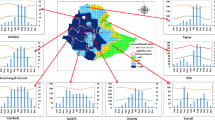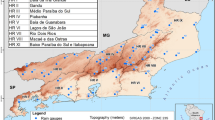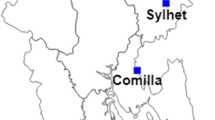Abstract
Significant positive trends are found in the evolution of daily rainfall extremes in the city of São Paulo (Brazil) from 1933 to 2010. Climatic indices including ENSO, PDO, NAO and the sea surface temperature at the coast near São Paulo explain 85 % of the increasing frequency of extremes during the dry season. During the wet season the climatic indices and the local sea surface temperature explain a smaller fraction of the total variance when compared to the dry season indicating that other factors such as the growth of the urban heat island and the role of air pollution in cloud microphysics need to be taken into account to explain the observed trends over the almost eight decades.







Similar content being viewed by others
References
Berbery EH, Doyle ME, Barros V (2006) Tendencias regionales en la precipitación. In: Barros V, Clarke R, Silva Días P (eds) El cambio climático en la Cuenca del Plata. CONICET, Buenos Aires, pp 67–92
Bornstein R, Lin Q (2000) Urban heat islands and summertime convective thunderstorms in Atlanta: three case studies. Atmos Environ 34:507–516
Carrió G, Cotton WR (2011) Effects of the urban growth of Houston on convection and precipitation. Part II: dependence of aerosol effects on instability. Atmos Res 97. doi:10.1016/j.atmosres.2011.06.022
Carrió G, Cotton WR, Cheng YY (2010) Effects of the urban growth of Houston on convection and precipitation. Part I: the August 2000 case. Atmos Res 96:560–574. doi:10.1016/j.atmosres.2010.01.005
Carvalho LMV, Jones C, Liebmann B (2004) The South Atlantic Convergence Zone: intensity, form, persistence, and relationships with intraseasonal to interannual activity and extreme rainfall. J Clim 17:88–108. doi:10.1175/1520-0442(2004) 017<0088:TSACZI>2.0.CO;2
Carvalho LMV, Jones C, Silva AE, Liebmann B, Silva Dias PL (2010) The South American Monsoon System and the 1970s climate transition. Int J Climatol 31:1248–1256. doi:10.1002/joc.2147
Chagnon SA (1979) Precipitation changes in summer caused by St. Louis. Science 205:402–404
Changnon SA, Shealy RT, Scott RW (1991) Precipitation changes in fall, winter, and spring caused by St. Louis. J Appl Meteorol 30:126–134
Chen WY, van den Dool H (2003) Sensitivity of teleconnection patterns to the sign of their primary action center. Mon Wea Rev 131:2885–2899
Chiang JCH, Vimont DJ (2004) Analogous meridional modes of atmosphere–ocean variability in the tropical Pacific and tropical Atlantic. J Clim 17(21):4143–4158
Cooley D (2009) Extreme value analysis and the study of climate change. Climatic Change 97:77–83. doi:10.1007/s10584-009-9627-x
Dufek AS, Ambrizzi T (2008) Precipitation variability in São Paulo State, Brazil. Theor Appl Climatol 93:167–178. doi:10.1007/s00704-007-0348-7
Freitas ED, Rozoff CM, Cotton WR, Silva Dias PL (2007) Interactions of an urban heat island and sea breeze circulations during winter over the Metropolitan Area of São Paulo—Brazil. Boundary - Layer Meteorol 122:43–65
Freitas ED, Silva Dias PL, Carvalho VSB, Rocha CRM, Martins LD, Martins JA, Andrade MF (2009) Factors involved in the formation and development of severe weather conditions over the megacity of São Paulo. Eighth Symposium on the Urban Environment, Modeling and Forecasting in Urban Areas. Proceedings of the 89th AMS Annual Meeting, 2009
Grimm AM, Silva Dias PL (1995) Analysis of tropical–extratropical interactions with influence functions of a barotropic model. J Atmos Sci 52:3538–3555
Haylock MR, Peterson TC, Alves LM, Ambrizzi T, Anunciação YMT, Baez J, Barros VR, Berlato MA, Bidegain M, Coronel G, Corradi V, Garcia VJ, Grimm AM, Karoly D, Marengo JA, Marino MB, Moncunill DF, Nechet D, Quintana J, Rebello E, Rusticucci M, Santos JL, Trebejo I, Vincent LA (2006) Trends in total and extreme South American Rainfall in 1960–2000 and links with Sea Surface Temperature. J Clim 19:1490–1512
Hurrell JW (1995) Decadal trends in the North Atlantic Oscillation and relationships to regional temperature and precipitation. Science 269:676–679
Janowiak JE, Gruber A, Kondragunta CR, Livezey RE, Huffman GJ (1998) A comparison of the NCEP–NCAR reanalysis precipitation and the GPCP rain gauge–satellite combined dataset with observational error considerations. J Clim 11:2960–2979. doi:10.1175/1520-0442(1998) 011<2960:ACOTNN>2.0.CO;2
Kalnay E, Cai M (2003) Impact of urbanization and land-use change on climate. Nature 423:528–531
Kalnay E et al (1996) The NCEP/NCAR reanalysis 40-year project. Bull Am Meteorol Soc 77:437–471
Kharin VV, Zwiers FW, Zhang X, Hegerl GC (2007) Changes in temperature and precipitation extremes in the IPCC ensemble of global coupled model simulations. J Clim 20:1419–1444. doi:10.1175/JCLI4066.1
Liebmann B, Jones C, Carvalho LMV (2001) Interannual variability of daily extreme precipitation events in the state of Sâo Paulo, Brazil. J Clim 14:208–217
Mantua NJ, Hare SR, Zhang Y, Wallace JM, Francis RC (1997) A Pacific interdecadal climate oscillation with impacts on salmon production. Bull Am Meteorol Soc 78:1069–1079
Marengo JA, Liebmann B, Kousky VE, Filizola NP, Wainer IC (2001) Onset and end of the rainy season in the Brazilian Amazon basin. J Clim 14:833–852. doi:10.1175/1520-0442(2001) 014<0833:OAEOTR>2.0.CO;2
Min S-K, Zhang X, Zwiers FW, Heger GC (2011) Human contribution to more-intense precipitation extremes. Nature 470:378–381. doi:10.1038/nature09763
Penalba O, Robledo FA (2010) Spatial and temporal variability of the frequency of extreme daily rainfall regime in the La Plata Basin during the 20th century. Clim Chang 98(3–4):531–550
Pereira Filho AJ, Santos PM, Camargo R, Festa M, Funari FL, Salum ST, Oliveira CT, Santos EM, Lourenço PR, Silva EG, Garcia W, Fialho MA (2007) Caracterização do Clima e sua Evolução na Região Metropolitana de São Paulo. In: Pereira Filho; Marques dos Santos; Xavier. (Org.) Evolução do Tempo e do Clima na Região Metropolitana de São Paulo, 1 ed. Linear B, São Paulo, vol 1, pp 99–120 (in Portuguese)
Rana A, Uvo CB, Bengtsson L, Parth Sarthi P (2011) Trend analysis for rainfall in Delhi and Mumbai, India. Clim Dyn. doi:10.1007/s00382-011-1083-4
Robertson AW, Mechoso CR (1998) Interannual and decadal cycles in river flows of southeastern SouthAmerica. J Clim 11:2570–2581
Rodionov SN (2004) A sequential algorithm for testing climate regime shifts. Geophys Res Lett 31:L09204. doi:09210.01029/02004GL019448,012004
Satyamurty P, Nobre CA, Silva Dias P (1998) South America. In: Karoly D, Vincent DG (ed) Meteorology of the southern hemisphere. Meteorol Monogr 27, 119–139
Shepherd JM, Pierce H, Negri AJ (2002) Rainfall modification by major urban areas: observations from spaceborne rain radar on the TRMM satellite. J Appl Meteorol 41:689–701
Silva Dias MAF, Vidale PL, Blanco CMR (1995) Case study and numerical simulation of the summer regional circulation in Sao Paulo, Brazil. Boundary - Layer Meteorol 74:371–388
Silva AE, Carvalho LMV (2007) Large-scale index for South America Monsoon (LISAM). Atmos Sci Lett 8:51–57. doi:10.1002/asl.150
Sugahara S, Rocha RP, Silveira R (2009) Non-stationary frequency analysis of extreme daily rainfall in Sao Paulo, Brazil. Int J Climatol 29:1339–1349. doi:10.1002/joc.1760
Sugahara S, Rocha RP, Ynoue RY, Silveira RB (2011) Homogeneity assessment of a station climate series (1933–2005) in the Metropolitan Area of São Paulo: instruments change and urbanization effects. Theor Appl Climatol. doi:10.1007/s00704-011-0485-x
Towler E, Rajagopalan B, Gilleland E, Summers RS, Yates D, Katz RW (2010) Modeling hydrologic and water quality extremes in a changing climate: a statistical approach based on extreme value theory. Water Resour Res 46:W11504. doi:10.1029/2009WR008876
Villaça FJM (1978) The territorial structure of the Brazilian Southern megacity (A estrutura territorial da metrópole sul brasileira). Ph. D. Thesis. FFLCH/USP, Departamento de Geografia. (in Portuguese)
Wilks DS (2006) Statistical methods in the atmospheric sciences, 2nd edn. International Geophysics Series, vol 91, Academic Press, 627 pp
Wolter K, Timlin MS (1993) Monitoring ENSO in COADS with a seasonally adjusted principal component index. Proc. of the 17th Climate Diagnostics Workshop, Norman, OK, NOAA/NMC/CAC, NSSL, Oklahoma Clim. Survey, CIMMS and the School of Meteor., Univ. of Oklahoma, 52–57
Xavier TMS, Xavier AFS, Silva Dias MAF (1994) Evolução da precipitação diária num ambiente urbano: o caso da cidade de São Paulo. Rev Bras Meteorol 9:44–53 (in Portuguese)
Zhang Y, Wallace JM, Battisti DS (1997) ENSO-like interdecadal variability: 1900–93. J Clim 10:1004–1020
Zhang X, Zwiers FW, Li G (2004) Monte Carlo experiments on the detection of trends in extreme values. J. Clim 17:1945–1952
Acknowledgments
This work has been supported by FAPESP and CNPq. JD acknowledges the support of a NRC Research Associate fellowship. LMVC acknowledges the support of NOAA NA10OAR4310170 and NSF 1126804. PLDSD acknowledges the support of the Inter-American Institute for Global Change Research.
Author information
Authors and Affiliations
Corresponding author
Electronic supplementary material
Below is the link to the electronic supplementary material.
ESM 1
(PDF 529 kb)
Rights and permissions
About this article
Cite this article
Silva Dias, M.A.F., Dias, J., Carvalho, L.M.V. et al. Changes in extreme daily rainfall for São Paulo, Brazil. Climatic Change 116, 705–722 (2013). https://doi.org/10.1007/s10584-012-0504-7
Received:
Accepted:
Published:
Issue Date:
DOI: https://doi.org/10.1007/s10584-012-0504-7




